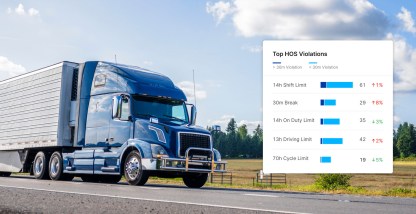Every industry has specific regulations and guidelines that must be adhered to remain compliant and operate safely.
Oilfield drivers often operating large, heavy vehicles with hazardous or flammable contents have even more safety precautions and regulations to adhere to. This is true for commercial fleets of all sizes, as a violation can result in financial penalties.
There are, however, some exemptions. Oilfield DOT regulations differ somewhat from those of the average commercial truck driver because of the different processes required for transporting oil and gas.
Are oilfield drivers subject to FMCSA compliance?
Like most other commercial fleet drivers, your fleet of oil and gas drivers must adhere to the driving regulations set by the Federal Motor Carrier Safety Administration (FMCSA). Subject to exemptions, here are a few rules that apply to oilfield commercial drivers:
- Drivers must have at least one 30-minute off-duty break if driving for more than eight hours
- Drivers must not drive for more than 11 hours within a timeframe of 14 hours
- Drivers must not drive for more than 60 hours within seven days
These regulations are in place for the driver’s well-being as well as ensuring road safety, and should be followed to ensure safe driving.
Are there hours-of-service (HOS) exemptions for oilfield drivers?
While all commercial drivers must adhere to FMCSA regulations, there are a few cases in which oilfield drivers are eligible for DOT oilfield exemptions.
24-hour restart
The FMCSA oilfield exemption was first introduced in 1962, beginning with the 24-hour restart rule.
The 24-hour restart rule applies to all fleet drivers who transport exclusively for oil and gas operations, and essentially means that oilfield drivers can get a restart after only 24 hours — instead of the 34 hours usually applicable to commercial truck drivers.
Fleets that fall under this exemption include those that directly transport goods for the oil and gas industry, such as equipment, water, and waste. The 24-hour window can apply at any time during the seven-day working period.
Waiting time
Another FMCSA oilfield exemption relates to waiting time.
Oilfield drivers are more likely to spend time waiting at well sites. Because these waiting periods can be somewhat lengthy, the driver can log this time as off-duty.
Oilfield drivers can also choose not to count their waiting time as part of the 14-hour timeframe, during which they’d usually not be able to drive more than 11 hours.
However, it’s essential to note that drivers who log their waiting time as off-duty can’t also use the 150 air-mile radius driver short-haul exemption (395.1(e)(1)), which is when a driver would be eligible for a 30-minute break within an eight-hour timeframe.
Fleet drivers in the oil and gas sector can use the Motive Vehicle Gateway and Driver App to record waiting times.
Split breaks
Oilfield DOT regulations state fleets that operate solely for the oil and gas industries can split their break times.
So long as the driver takes their break in a sleeper berth or sleeping facility at a well site, they can split their 10-hour break into at least two-hour segments. For example, a driver could take five two-hour breaks or two five-hour breaks to meet the requirements set by the FMCSA. This is specified in Section 395.1(g)(2).
As long as they take the necessary breaks and meet the delivery needs of their fleet, they may choose how they’d best benefit from split breaks.
These breaks don’t fall under the 14-hour window of driving time.
Can vehicles operate under the oilfield exemption when not hauling oil products?
No. Under the current regulations, the DOT oilfield exemptions only apply to fleet drivers who specifically haul oil products.
In most cases, the type of hauled equipment that qualifies the driver for the exemptions are:
- Heavy-coil vehicles
- Nitrogen pumps
- Wire-line trucks
- Storage trailers
- Missile trailers
- Cement pumps
- Sand storage trailers
- Hydration pumps
- Separators
Other commercial fleet drivers may not qualify for the oilfield exemptions. This includes drivers who transport supplies for the oil and gas industry but don’t fall under the above list.
For example, drivers transporting equipment, supplies, and materials such as water and sand may not be exempt from the regulations, even if they’re hauling goods specifically for the oilfield industry.
Oilfield drivers: Penalties for violating hours-of-service regulations
Hours of Service regulations reduce driver fatigue and ensure optimum road safety, meaning it’s of the utmost importance that fleet managers and drivers fully understand the HOS rules.
Commercial drivers can be put out of service for Hours of Service violations. In addition, drivers may also be penalized and fined. According to the regulations, recordkeeping violations can lead to a maximum civil penalty of $1,307 for each day the violation continues, up to $13,072.
It should also be noted that regular violations can impact safety ratings and CSA scores, which may negatively affect the credibility of a business as well as future business opportunities.
Learn how oil and gas companies can increase compliance and profits in this article.
Manage oil and gas Hours of Service with Motive
Fleet managers should be responsible for ensuring all their drivers adhere to the HOS regulations. Of course, you can’t be there with them in the vehicle to ensure they take the necessary breaks at the right time or comply with the other regulations.
This is where Motive can help.
Motive makes Hours of Service compliance simple with our Vehicle Gateway and Driver App. In addition, Motive’s real-time GPS tracking solution can also help fleet managers monitor any breaks that drivers take on the road.
With Motive’s GPS Vehicle Tracking system, fleet managers can monitor their vehicles live to see where they are, where they’re going, and the duration of their stops. The technology pinpoints the vehicle’s exact location and shares the location for fleet managers to review.
It minimizes check-in calls and confirms that your drivers follow regulations to ensure optimum road safety, benefitting your fleet and other commercial and passenger drivers on the road.
Request a free demo today to learn more about the Motive compliance and fleet management solution and how we’re helping oilfield drivers and fleets stay compliant, efficient, and productive.








